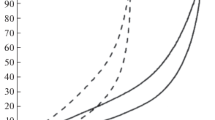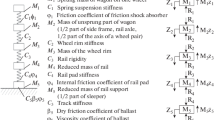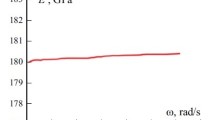Abstract—The stiffness and damping properties of various-thickness samples made of a composite material based on a rubber mixture, rubber fiber composite material, and thermoplastic elastomers of various stiffnesses are studied under static and dynamic loading conditions at a temperature of 23 and –40°C. The composites based on a rubber mixture and the rubber fiber composites are recommended for the dampers that work in regions with low climatic temperatures. The stiffness and damping properties of a real object are assumed to be estimated using the elastic hysteretic properties of a test sample.
Similar content being viewed by others
Explore related subjects
Discover the latest articles, news and stories from top researchers in related subjects.Avoid common mistakes on your manuscript.
INTRODUCTION
One of the main requirements imposed on the damping materials of rail structures is active absorption of vibrations for a long time over a wide climatic temperature range. The properties of elastomers are substantially determined by vitrification. For each type of polymers, the transition from a highly elastic state into a glassy state is characterized by the glass transition temperature at which a material loses its elastic properties [1–5]. If the glass transition temperature is higher than the operating temperature, the polymer is used in a glassy state; otherwise, it is used in a highly elastic state. However, the cold resistance of elastomers determined under static loading cannot characterize the actual cold resistance under any operating conditions, since the glass transition temperature changes under periodic loading [6]. Therefore, it is reasonable to estimate the performance of polymer materials for rail transport from the changes in the stiffness and energy characteristics as functions of the temperature and the amplitude and frequency of a periodic load [7, 8].
Our earlier experimental investigations of the damping properties of advanced composite materials TPRK, RVK, TEP1nzh, and TEP2vzh [9] showed that the elastic hysteresis parameters are effective criteria for choosing materials for the damping elements of the upper structure of a rail track and rolling stock at normal temperature. However, the problems of the behavior of these materials at low temperatures under static and periodic dynamic loading and the influence of the geometric parameters on the stiffness parameters are still poorly investigated.
The purpose of this work is to study the elastic hysteretic properties of samples of various thicknesses made of polymer composite materials for rail transport at a temperature of 23 and –40°C under static and dynamic loading.
EXPERIMENTAL
We studied the following four polymer compositions [9]: TPRK polymer composite material based on a rubber mixture; a fiber rubber RVK composite material based on SKI-3 rubber modified by a filler, namely, 20 wt % fragmented rubber polyamide cord; and TEP1nzh and TEP2vzh composite thermoplastic elastomers having different stiffnesses.
The samples were 14 × 142 × 205-mm plates. The nonstandard sample sizes are caused by the real sizes of the damping elements located between a rail and a tie, the thickness of which depends on operating conditions. Taking into account the tendency toward an increase in the stiffness of designed dampers to maintain stable geometric sizes under heavy-car motion, we also studied small-thickness (10 mm) TPRK samples to determine the influence of the plate thickness on the elastic hysteretic properties of the materials.
The tests were carried out according to the technique described in [9]. Static loading was performed at a loading rate of 120 ± 10 kN/min, and dynamic loading was performed at a loading frequency of 10 Hz and a loading amplitude of 20–90 kN. Samples were held in a heat chamber at a temperature of –40°C for 4 h and were then subjected to force loading to determine the stiffness characteristics under low-temperature action. The change in the sample thickness during tests was determined using two inductive mechanical motion transducers, and the transducer readings were averaged. The load was controlled using the readings of the force-measuring transducer of the testing machine.
The following characteristics were determined: static stiffness at a temperature of –40 and 23°C,
where F90 and F20 are the maximum and minimum loads (kN) in the loading cycle, respectively, and z90 and z20 are the changes in the sample thicknesses at loads of 90 and 20 kN, respectively; static stiffness change factor
where Cstat 1 and Cstat 0 are the static stiffnesses (kN/mm) at –40 and 23°C, respectively; dynamic secant stiffness at –40 and 23°C,
where Fmax and Fmin are the maximum and minimum loads (90 and 20 kN, respectively) in the loading cycle (kN), respectively, and zmax and zmin are the changes in the specimen thickness at the corresponding loads (mm);
dynamic tangential stiffness determined at –40 and 23°C,
stiffness factor at –40 and 23°C,
where Cdin and Cstat are the dynamic and static stiffnesses (kN/mm), respectively; mechanical loss factor (relative hysteresis) at –40 and 23°C, which is the ratio of the mechanical loss per cycle (hysteresis area) to the total cycle deformation energy (area bounded by a loading branch);
useful elasticity (fraction of returned energy of the energy consumed for sample deformation) at –40 and 23°C,
where Sb and S are the areas of the diagrams bounded by the straight line that is parallel to axis OX and passes through point y = 20 kN and by the unloading or loading hysteresis branch; and the mechanical losses per cycle (hysteresis loop area).
RESULTS AND DISCUSSION
Figures 1 and 2 and Table 1 present the stiffness characteristics of the TPRK samples of various thicknesses at –40 and 23°C. An analysis of the results demonstrates that, at the chosen test temperatures, the stiffness of TPRK depends on the sample thickness and changes in proportion to the ratio of the sample thicknesses; that is, the results differ by a factor of 1.4 (see Table 1). The relative quantities, namely, the stiffness coefficients, the mechanical loss factor, and the useful elasticity, are constants for the given material and are thickness independent. The mechanical losses per cycle are inversely proportional to the change in the material thickness.
Thus, we can state that, to design the damping elements of the upper structure of a rail track and rolling stock that are intended for operation in various climatic zones, it is sufficient to determine the elastic hysteretic properties of a test sample at a chosen temperature and to calculate the required characteristics of a real object using a coefficient of proportionality.
The stiffness characteristics of all materials under study are presented in Figs. 3 and 4 and Table 2. A comparative analysis demonstrates that both the static and dynamic stiffnesses of the TEP1nzh and TEP2vzh thermoplastic elastomers increase at –40°C (by a factor of ≈4 and ≈15, respectively); that is, the TEP1nzh and TEP2vzh composite thermoplastic elastomers are used in a glassy state, and their glass transition temperature is above –40°C. In turn, the static stiffness of the rubber (which is the base of TPRK and RVK) increases only by 10% and its dynamic stiffness, by a factor of ≈3.5. Thus, the materials made of the “rubber” composites do not lose their elastic properties at –40°C, and the composites made of the thermoplastic elastomers operate as an elastic solid body.
A comparative analysis of the stiffness characteristics of the materials under static and dynamic loading conditions shows that more than a fourfold increase in the stiffness coefficient can be a limiting state criterion for damping materials.
Both rubber composites (TPRK, RVK) have similar static stiffness characteristics, and their dynamic characteristics at 23°C differ by ≈20%, which is related to the densification of the boundaries between the matrix and the cord filler of RVK during cyclic action. At –40°C, the difference between the stiffness parameters of these materials almost disappears, which is associated with a break in the additive action of the RVK components.
At –40°C, the mechanical loss factor, which is the ratio of the dissipated deformation energy to the total deformation energy, of the TPRK and RVK composites decreases by 25–30%, and their useful elasticity increases (see Table 2). Therefore, these materials return a significant part of the energy to the next cycle of the vibrating system, which is related to the deceleration of relaxation processes and the beginning of crystallization. It should be noted that the mechanical losses of RVK per deformation cycle at positive and negative temperatures are almost the same. At –40°C, they become equal to the losses of the TPRK composite material. Therefore, the cord filler decreases the mechanical losses at positive temperatures, and energy is dissipated at –40°C only due to the elastic work of the rubber binder.
At –40°C, the mechanical losses of the composites made of the thermoplastic elastomers decrease by an order of magnitude because of the fact that they operate in a glassy state like a solid body. The dynamic hysteresis width of the TEP2vzh material, which characterizes the cyclic viscosity (i.e., the lag between unloading deformation and loading deformation), is minimal (≈0.01 mm), which indicates its higher sensitivity to crystallization as compared to TEP1nzh (see Fig. 4b). The TEP2vzh material exhibits an atypical change in the relative energy parameters (mechanical loss factor, useful elasticity) at different temperatures, which is related to a change in the deformation mechanism.
CONCLUSIONS
(1) The relation between the stiffness characteristics of TPRK samples of various thicknesses is identical to that between their thicknesses. Other damping materials are assumed to behave similarly in the highly elastic deformation range.
(2) At –40°C, the materials made of rubber TPRK and RVK composites do not lose elastic properties during both static and dynamic loading, and the composites made of TEP1nzh and TEP2vzh thermoplastic elastomers operate in a glassy state. The mechanical losses of the composites made of thermoplastic elastomers decrease more than fourfold as compared to the rubber composites. Therefore, the TPRK and RVK composite materials should be applied for the dampers that have to work in regions with low climatic temperatures.
(3) The additive action of a cord filler introduced to increase the stiffness and the matrix of the rubber RVK composite material is effective at operating temperatures above –40°C. At lower temperatures, the stiffness of the material is thought to be determined by the stiffness of the rubber mixture.
REFERENCES
V. P. Matveenko, O. Yu. Smetannikova, N. A. Trufanov, and I. N. Shardakov, Thermomechanics of Polymer Materials under Relaxation Transition Conditions (Fizmatlit, Moscow, 2009).
G. M. Bartenev and S. Ya. Frenkel’, Physics of Polymers, Ed. by A. M. El’yashevich (Khimiya, Leningrad, 1990).
V. N. Kuleznev and V. A. Shershnev, Chemistry and Physics of Polymers (Koloss, Moscow, 2007).
L. V. Sokolova, “Vitrification of polymers and low-molecular liquids,” Plastich. Massy, No. 5, 13–21 (2006).
T. R. Manley, “Thermal analysis of polymers,” Pure Appl. Chem. 61 (8), 1353–1360 (1989).
M. F. Bukhina and S. K. Kurlyand, Cold Resistance of Elastomers (Khimiya, Moscow, 1989).
A. V. Afanas’ev, L. N. Rabinskii, and P. V. Shershak, “Experimental determination of deformation and strength characteristics of polymer composite materials,” Mekhan. Kompoz. Mater. Konstr. 16 (2), 214–232 (2010).
V. K. Semenov and A. E. Belkin, “Experimental study of the hysteretic properties of protector rubber under the cyclic loading conditions characteristic of tires,” Izv. Vyssh. Uchebn. Zaved., Mashinostr., No. 2, 9–14 (2013).
E. G. Kurzina, A. G. Kolmakov, Yu. N. Aksenov, A. M. Kurzina, A. Yu. Bogachev, and A. V. Semak, “Comparison of the composite materials intended for damping elements for the infrastructure of rail transport and rolling stock,” Deform. Razrushenie Mater., No. 12, 39–48 (2018).
Funding
This work was performed in terms of state assignment no. 007-00129-18-00.
Author information
Authors and Affiliations
Corresponding author
Additional information
Translated by K. Shakhlevich
Rights and permissions
About this article
Cite this article
Kurzina, E.G., Kolmakov, A.G., Aksenov, Y.N. et al. Elastic Hysteretic Properties of Damping Composite Materials for Rail Transport at Low Temperatures under Static and Dynamic Loading. Russ. Metall. 2019, 1138–1142 (2019). https://doi.org/10.1134/S0036029519100161
Received:
Revised:
Accepted:
Published:
Issue Date:
DOI: https://doi.org/10.1134/S0036029519100161








